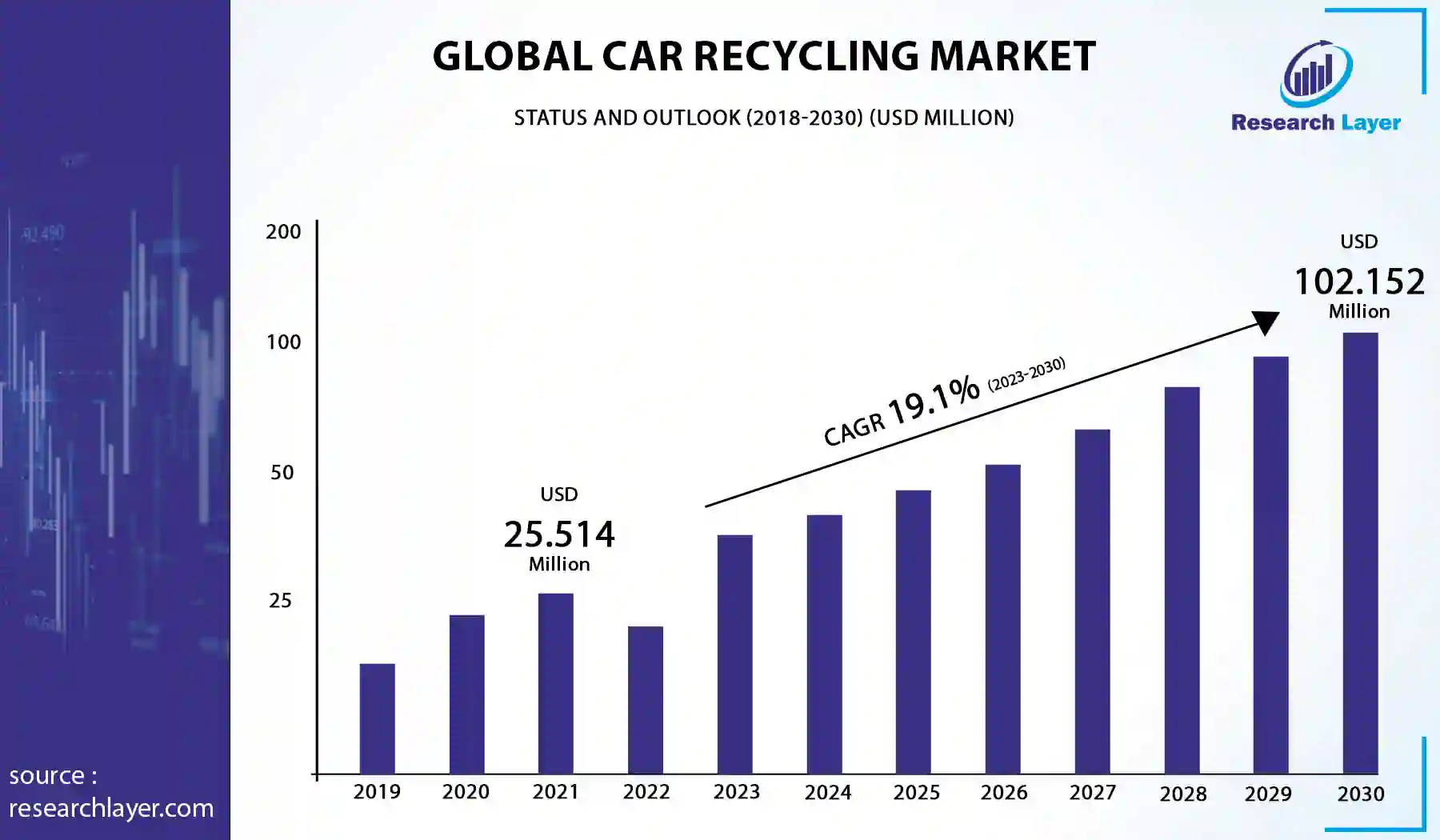 +1 915 229 3004 (U.S.) |
+1 915 229 3004 (U.S.) |  +44 7452 242832 (U.K.)
+44 7452 242832 (U.K.)
 +1 915 229 3004 (U.S.) |
+1 915 229 3004 (U.S.) |  +44 7452 242832 (U.K.)
+44 7452 242832 (U.K.)


Research Layer announces the publication of its half-cooked research report—Global Car Recycling Market, 2022-2030
The global Car Recycling market is projected to reach USD 102.152 million by 2030, from USD 25,514 million in 2021 and is anticipated to register a CAGR of 19.1% between 2022 and 2030.
Automobiles can be recycled in a number of ways, including the reuse of restored parts and the shredding and recycling of materials including plastics, aluminium, and steel. The automobiles that have reached the end of their useful lives are crushed at recycling plants to separate the parts and recover the metals and plastics. Dismantling, crushing, shredding, and material recovery are the four main technological developments in the recycling of ELV vehicles. The wheels, tyres, and suspension are all removed and replaced, as well as any sheet metal, appealing components, gas, seats, sound system, and so on. In the category of metals, steel is the most widely recycled material. This is followed by ferrous and nonferrous metals. The annual amount of recycled steel from retired vehicles exceeds 18 million tonnes. The non-ferrous metals are separated into pure surges of material using division technologies including swirl current, laser, infra-red, and buoyancy partition innovations, and then sent on for further purification.
The global Car Recycling Market has been segmented based on Material, Part, Application and Region/Country.
On the basis of Material, the global market is segmented into metal, plastic and others.
On the basis of Part, the global market is segmented Door Panel, Gas Tank, Engine & Transmission, Wheels and others.
On the basis of Application, the global market is segmented into passenger car and commercial cars.
The global Car Recycling Market has been analyzed for five Regions—North America, Europe, Asia-Pacific, the Middle East & Africa, and South America.
To address the rising material costs and encourage recycling, governments around the world, have been proactive in placing hefty levies on the import of virgin steel. As a result, manufacturers must resort to using recycled steel in their vehicles. The Automotive Recyclers Association (ARA) and the United States Environmental Protection Agency are just two of the many recycling trade groups and governments working to mitigate the problem via the use of practical measures. It is mandatory that automakers and suppliers use only recycled or restored components. Growing recycling innovations and the launch of new brands like ARA's Green Recycled Parts (GRP) are anticipated to fuel the market going forward.
Approximately 39 different plastics and polymers are used in cars nowadays. High-cycle-value recyclers are put to the test when faced with a wide variety of plastics and polymers. However, it is anticipated that increasing environmental standards and an increasing focus on recycling plastics will aid the recycling rate of plastics used in interiors, guards, and gas tanks. Due to rising numbers of cars and ageing vehicles, the auto recycling market is anticipated to grow rapidly over the forecast time frame. There's a subtle reference to turning cars into scrap metal. Parts made of steel and iron are particularly sought after by auto recyclers due to their high degree of recyclability. Acquiring polymers, liquids, and common materials for trade or reuse is also an important aspect of recycling. In a single year, about 27 million automobiles around the world reach the end of their useful life. The large number of cars sent to recycling facilities includes both older models and those that have been in collisions.
Rising consumer consciousness, the need to reduce emissions of substances that deplete the ozone layer, and the availability of incentives for recycling automobiles all serve as major forces propelling the market. The metal recycling market is propelled by the rapidly expanding industrialization and urbanisation of developing economies and the increasing sensitivity of consumers. In order to manage the steady stream of abandoned cars that are sent to them, auto recyclers are adopting cutting-edge processes and technologies. The growing benefits of auto recycling, such as keeping potentially hazardous fluid out of landfills and providing access to thousands of barrels of oil that may be used in alternative designs, are bolstering the expansion of the automotive industry.
As time goes on, we anticipate that the North American market will continue to be the most lucrative. To the tune of several billion dollars annually, the recycling of automobiles is a highly visible sector that supports the employment of over one hundred thousand Americans. The United States has the highest vehicle recycling rate in the world and consequently controls a sizable fraction of the global car recycling business. The Asia-Pacific region is a major player in global vehicle production; nevertheless, the recycling rate for automobiles is rather low in developing countries in the region. Market growth for recycled auto parts is anticipated in the region as a result of rising public interest in environmental issues and active government efforts to promote green plans of action.
The key players in the global Car Recycling Market are Scholz Recycling GMBH, Schnitzer Steel Industries, Inc., LKQ Corporation, Toyota Motor Corporation, Sims Metal Management Limited,European Metal Recycling (EMR), Hensel Recycling Group, Volkswagen AG, Tianqi Automation Engineering Co., Ltd., Keiaisha Co., and INDRA.